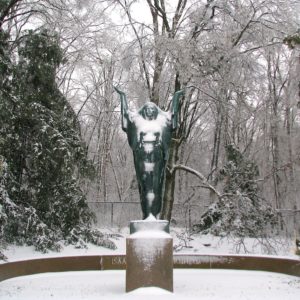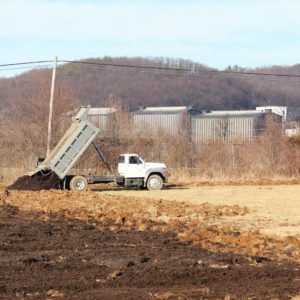The Edible Garden project requires soil. Lots of soil. It’s a garden after all. And since it is being located on a patch of land that has been highly impacted over the past 50 years, it needs good healthy soil. The options turn out to be, a) buy the soil, or b) make the soil. To minimize the carbon footprint in obtaining a lot of soil quickly here’s how we elected to approach the problem:

On February 3rd, 2009 a very healthy ice storm hit and Bernheim took a heavy blow. Lots of wood was put on the ground by the storm. Wood is mostly cellulose and lignin, which is to say that it is mostly Carbon, Hydrogen and Oxygen. It’s amazing what those three elements can achieve.
All that wood was drug to the road, chipped, and dumped into a huge pile located in our nursery. It took fuel to chip and haul the wood. Gasoline, which is to say mostly Carbon and Hydrogen. The dead wood goes through chemical and physical changes releasing CO2 into the atmosphere. Biological changes happen as well. The decaying wood develops a new ecology.
On February 25th, 2013, a bit more than four years after the storm, the mostly decayed pile of wood was scooped up by a big machine, dumped into another machine and hauled to a five-acre patch of old farm that is now Bernheim’s nursery. All that digging, dumping and hauling required more Carbon and more Hydrogen in the form of gasoline.
The piles of rotting wood were dumped on the patch of old farm land, spread around with a big machine, plowed into the soil with another big machine, and left to be.

More chemical, physical and biological changes then take place. The soil chemistry becomes more complex and millions, no billions, of living things that are always in our soil encounter new chemical conditions and respond. Most of what happens at this point is unknown to us. The ecology of soil is really a wilderness.
The plan is to go back and rob that patch of soil. After we scoop it up we’ll move it to the garden not far away. Some will cover areas to be landscaped, some will be put into raised beds and some will help us sculpt the landscape so we can optimize the way we move water through the Edible Garden.
It will be a trick to take a stab at accounting for all the credits and debits of the carbon, hydrogen and oxygen through the growing of trees, the rotting of wood, the messing about with piles, and eventually, the production of new carbon in the form of food. Most likely we will be way off the mark. But thats because we are just getting our feet wet. But we are getting our feet wet.

Speaking of wet, everything I just described happened within sight of tens of thousands of barrels of bourbon. Cause that’s how we roll. Alcohol is just another arrangement of Carbon, Hydrogen and Oxygen. Alcohol is to bourbon as cellulose is to soil.
This isn’t the end of the story. It’s the beginning.
[slider_pro id=”14″]
Here’s a link to a NASA web site that has some poems about soil done by children. Some of them are just getting their feet wet too.

